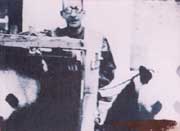|
After David introduced the giant panda to the world, a "giant panda mania" swept some western countries. Many zoologists, explorers, travelers and hunters came to China from far away, with the purpose of catching a rare giant panda. However, it's very hard to find giant pandas because they usually live alone in the thick forest of mountain areas. 
Among the cases in historical records, one example is that two Russian got a giant panda fur in an area around Pingwu and Songpan of Sichuan Province. German zoologist Hugo Weigold caught a live giant panda in Wenchuan of Sichuan Province and became the first westerner who owns a live panda. The foreigner who got most giant pandas from China is the British F.T. Smith. He stayed for 20 years in the living place of giant pandas and was called "King of Giant Pandas" by the westerners. From 1936 to 1938, Smith bought 12 live giant pandas in Wenchan of Sichuan Province, among which only 6 were shipped to Britain alive.
Two sons of President Roosevelt were the first two Americans who came to China to hunt giant pandas. In 1928, Kermit and Theodore Roosevelt, traveled to Baoshan county of Sichuan but failed to get a giant panda. The two then went to Yuexi county of the Liangshan Mountain where they killed a grown-up female panda, writing the first page of killing pandas by westerners. Thereafter, following the steps of the Roosevelt brothers, Sage and Sheldon from the United States of America, Shaffer from Germany, and Brockhurst from UK all came and killed giant pandas with their own hands. There are more westerners who killed or hunted giant pandas through the hands of the Chinese°™for instance, they buy giant pandas at high prices.
The first person to bring a living giant panda out China was a female American fashion designer named Ruth Harkness. Her husband William Harkness, an adventurer and a zoologist, set off to China to capture giant pandas soon after their marriage. The man was unfortunate in that he died before he had the chance to enter the habitat of giant pandas. Ruth Harkness traveled into Wenchuang County of Sichuan Province, then to Baoxing county where David found the first panda, to follow in her husband's footsteps and began the hard task of searching for giant pandas.
 Perhaps chances always favor those who persist to the end. Ruth eventually found a less-than-two-pound panda cub that had been born for about 30 days in the bamboo forest 2 kilometers from the Jiajin Mountain. So excited, Ruth took care of the panda cub like her own baby. In her journal, she wrote, "it has a black-and-white ball-like head. When rubbing its nose over my shirt, it often finds my breast by instinct. With the help of her friends, Ruth bribed the custom officers and took Sulin on the ship and then outside China. The panda cub Sulin was carried through in a bamboo basket but customs recorded "taking along a barking dog." In the spring of 1937, Sulin was exhibited in the Chicago Zoo of the United States and soon became a star of the city, attracting as many as 40,000 visitors to the zoo. From then on, the story of Sulin and Ruth became well-known, and another world panda mania came about. Giant panda then became a cash cow and an object of internal hunting. In the mere five years from 1936 to 1941, just America has taken nine living pandas from China. According to the statistics, between 1869 to 1946, more than 200 foreigners had come to the panda habitat in China to investigate, collect information, hunt, kill or buy living giant pandas or panda specimens. 16 living giant pandas had been taken from China during the ten years between 1936 to 1946, and at least 70 giant panda specimens are stored in Foreign museums. Perhaps chances always favor those who persist to the end. Ruth eventually found a less-than-two-pound panda cub that had been born for about 30 days in the bamboo forest 2 kilometers from the Jiajin Mountain. So excited, Ruth took care of the panda cub like her own baby. In her journal, she wrote, "it has a black-and-white ball-like head. When rubbing its nose over my shirt, it often finds my breast by instinct. With the help of her friends, Ruth bribed the custom officers and took Sulin on the ship and then outside China. The panda cub Sulin was carried through in a bamboo basket but customs recorded "taking along a barking dog." In the spring of 1937, Sulin was exhibited in the Chicago Zoo of the United States and soon became a star of the city, attracting as many as 40,000 visitors to the zoo. From then on, the story of Sulin and Ruth became well-known, and another world panda mania came about. Giant panda then became a cash cow and an object of internal hunting. In the mere five years from 1936 to 1941, just America has taken nine living pandas from China. According to the statistics, between 1869 to 1946, more than 200 foreigners had come to the panda habitat in China to investigate, collect information, hunt, kill or buy living giant pandas or panda specimens. 16 living giant pandas had been taken from China during the ten years between 1936 to 1946, and at least 70 giant panda specimens are stored in Foreign museums.
Western naming of Giant Panda in recent times

|



